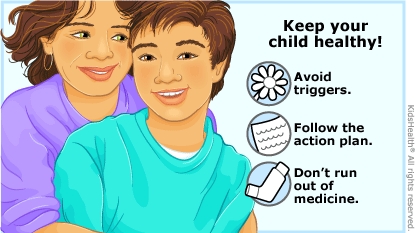Lots of kids have asthma. It is a chronic (ongoing) condition, which means it usually lasts for years. Many kids grow out of it. Kids with asthma have airways that sometimes can tighten and get plugged with mucus. This is called an asthma flare-up. During an asthma flare-up, a child may cough a lot, feel chest tightness, wheeze, or be short of breath.
The health care provider examined your child, asked questions about symptoms, then diagnosed your child with asthma. Sometimes health care providers give families an "asthma action plan," which is a written guide for controlling asthma and treating symptoms right away. The plan includes information about prescription medicines, how to avoid asthma triggers, and what to do if symptoms happen. It's important that you and your child understand the asthma action plan, know the signs of a flare-up, and know what to do if a flare-up happens.



Your child:

Your child has trouble breathing. Signs you might see include:
Call 911 if your child is struggling to breathe, is too out of breath to talk or walk, or turns blue.

What is an asthma flare-up? An asthma flare-up is when asthma symptoms get worse. These symptoms include wheezing, coughing, or feeling out of breath. People with asthma have airways that are overly sensitive to some things (called "triggers"). Being around triggers can bring on asthma symptoms by making the airways in the lungs narrower, swollen, and filled with mucus. Asthma flare-ups are also called asthma attacks or exacerbations. They can happen even when a person takes medicine to control their asthma.
What are common asthma triggers? Triggers can bring on asthma symptoms, but they don't cause asthma. Triggers are different for each person with asthma, but common ones include:
How do asthma medicines work? Asthma medicines generally work in two ways:
Some children will get both types of medicines from one inhaler device. They might need to use this "combination" inhaler every day, with added doses from it when they have symptoms. Some older kids with mild asthma might use a combination inhaler only for quick relief when they have symptoms, or before they exercise. Your health care team will help you figure out which inhaler is best for your child, and how and when to use it.
Are all asthma medicines breathed in, or can some be taken by mouth? Some medicines that ease inflammation can also be taken by mouth. For example, the health care provider may prescribe oral steroids for inflammation during a flare-up, usually for 5–7 days.